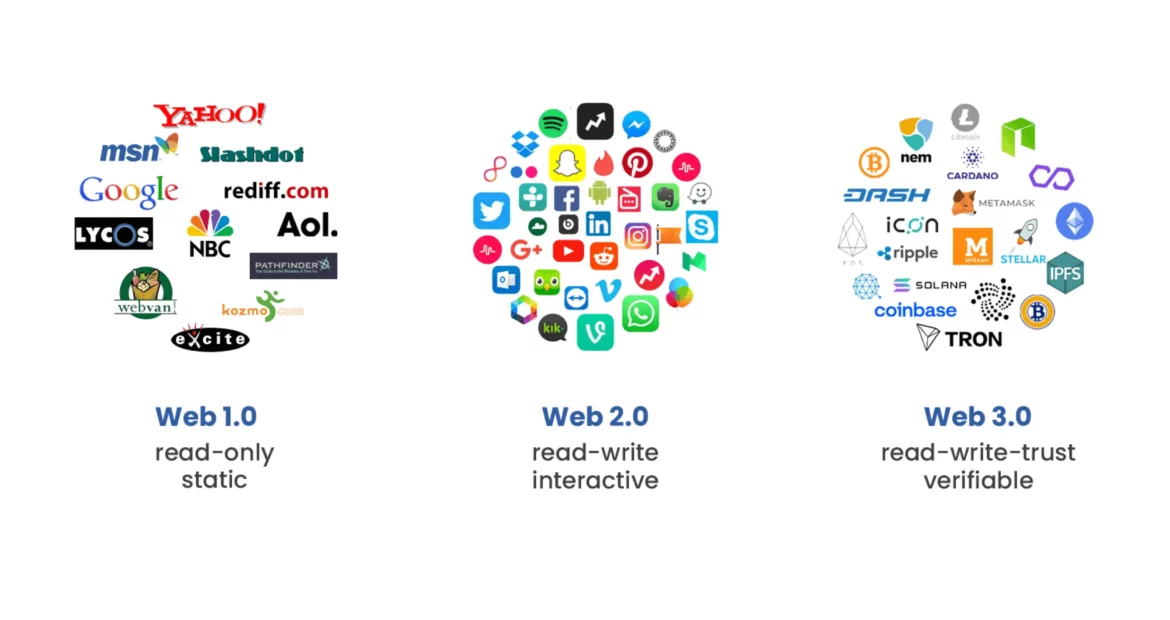Table of Contents
In this article, you’ll learn about The Difference Between Web 1.0, Web 2.0, Web 3.0 and more.
What is Web1.0
Web1.0 was the first and most reliable internet in the 1990s also it is so called first phase of World Wide Web. It was created as hyperlink information system.
Web1.0 was dominated by static websites which were used to display some information. These websites had no or very little interaction capabilities.
Consumers struggled to locate valuable information in Online 1.0 since there were no algorithms to scan through websites.
Some features of Web 1.0
- Read-only web
- Static web pages
- One-way publishing medium
- Page hyperlinking and bookmarking
- Content served from the server’s file system
- HTML forms are sent via email
- Only text mails could be written and sent – no option to attach images
- Use of frames and tables place and align the elements on a webpage
- Content comes from filesystem of the server instead of an RDBMS
What is Web2.0
The Web 2.0 period began in 2004 with the emergence of social media platforms. Instead of a read-only, the web evolved to be read-write. Instead of companies providing content to users, they also began to provide platforms to share user-generated content and engage in user-to-user interactions. As more people came online, a handful of top companies began to control a disproportionate amount of the traffic and value generated on the web.
Because of developments in web technologies such as Javascript, HTML5, CSS3, etc., and Web 2.0 made the internet a lot more interactive.
In web 2.0 or the current iteration of the web, tech giants such as Facebook (Meta), Twitter, Google, Apple, Microsoft, and Amazon, control how our personal data will be used. These companies use algorithms that decide the information that we consume.
Social networks and user-generated content production have flourished because data can now be distributed and shared.
A few ways how internet users in web 2.0 interact and share their thoughts, opinions, and experiences include:
- Social media
- Social networking
- Tagging
- Blogs
- Podcasts
- Web content voting
Some features of Web 2.0
- Read-write web
- Also known as participative web and social web
- Dynamic content with high responsiveness to user inputs
- User-generated content
- Interoperability for end-users
- User-friendly
What is Web3.0
Web 3.0 is the next break in the evolution of the Internet, allowing it to understand data in a human-like manner.
It uses AI technology, Machine Learning, and Blockchain to provide users with smart applications.
This will enable the intelligent creation and distribution of highly tailored content to every internet user.
It is known as the future of the internet. It involves a space where people operate on decentralised, almost anonymous platforms. This means moving away from the big, guiding hands of tech giants like Google, Facebook, and Twitter.
Web 3.0 was originally called the Semantic Web by World Wide Web inventor Tim Berners-Lee, and was conceived as a more autonomous, intelligent, and open internet.
Some features of Web 3.0
- Read-write-interact web
- Powered by blockchain
- The use of decentralized network provides data control of owners
- 3D visuals and graphics
- Uses artificial intelligence (AI) to provide fast results with accurate real-time insights
- Support for semantic web that understands the meaning of words
- Use of advanced authorization mechanisms for the protection of user data and identity
Web 1.0 vs Web2.0 vs Web3.0
| Web 1.0 | Web 2.0 | Web 3.0 |
| Read-only web | Read-write web | Read-write-execute web |
| The first stage of the internet | The second stage of the internet | The third stage of the internet |
| The purpose is information sharing | It is about interaction | It aims at immersion |
| The content was owned | Shared content | Content will be collectively owned and shared |
| More of a simple and passive web | More of a social Web | It is a semantic web |
| Focuses on connecting information | Focuses on connecting people | Revolves around connecting knowledge |
| Static websites | Introduction of web applications | Web-based intelligent functionalities and applications |
| No or little interaction between server and user | Better interaction between server and user | Designed to deliver a personalized web experience to the users |
| Technologies related to Web 1.0 include Web and File Servers, HTML, and Portals | Associated technologies include Ajax, JavaScript, CSS, and HTML5 | Technologies related to Web 3.0 include Blockchain, AI, decentralized protocols |
